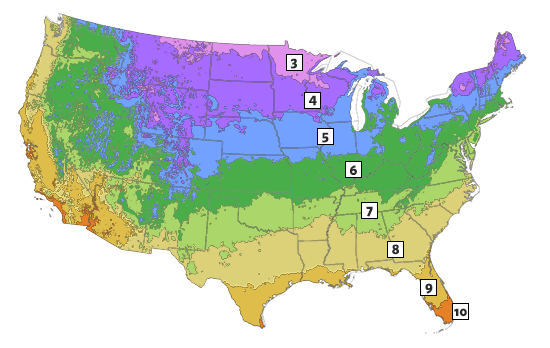If you live in Zone 9, then you should know it has a long growing season with hot summers and mild winters, so drought-tolerant plants and full-sun perennials are good choices. Its frost-free period lasts much of the year, from late February until late November. U.S. cities within this zone include Houston; Las Vegas; New Orleans; Orlando; and Tucson, Arizona. Flowering plants for zone 9 include astilbe, bee balm, cannas, coneflowers, crocus, croton, daffodils, dahlias, glads, hibiscus, hostas, hyacinths, irises, jasmine, phlox, salvia, sedum, snake plants and are some the plants for zone 9 that we recommend.
Don't forget that your property probably has several microclimates within it, each of which is best suited for different plant types and varieties. Take some time to determine which microclimates you have, whether it's an open area of your backyard that's always in direct sunlight, a shaded spot beneath a big tree, a rock-covered hill or a marshland. With a little practice, choosing the plants that will thrive in your various microclimates will soon become second nature.

Summer Bulbs
Spring-planted bulbs that bloom during the summer can thrive in most hardiness zones. What's more, they produce some of the most vibrant colours of the year. Varieties include dahlias, lilies, gladiolus, caladium, cannas, and begonias. In cooler regions, try planting summer bulbs outdoors in pots before transferring them--once the soil is warm enough--to your garden bed or border. Most can go in the ground once the possibility of frost has passed.
Planting Success: Step by Step
BegoniasSun Perennials
Sun perennials are revered for their versatility, attract pollinators to your landscape and produce countless, lovely blooms for years or even decades. No wonder these are some of the world's most popular flowers! Sun-loving perennials include roses, peonies, irises, daylilies, hibiscus, coneflowers and asters. These varieties perform best when receiving about 6-8 hours of direct sunlight per day. Without it, zone 9 perennials grow poorly, and their blooms, if any emerge, are drab and lifeless.
Planting Success: Step by Step
Bareroot RosesShade Perennials
Some gardeners don't even try to grow anything in the shaded areas of their gardens or yards. That's a shame, because some incredible plant varieties--including those that yield many delicate, colourful blooms--fare well when grown within dark shadows. We recommend such shade seekers as hellebores, astilbe, bleeding hearts, toad lilies, ferns, and hostas for zone 9. Poor soil can hinder a shade perennial garden more than a lack of sunlight, so be sure to add plenty of organic matter when preparing a new one. Avoid damaging roots when planting Shade Perennials near trees.
Popular Varieties
Planting Success: Step by Step
HostasThe U.S. Department of Agriculture's Plant Hardiness Zone Map, which divides the continental U.S. into eight gardening zones based on wintertime minimum temperature averages, can help you select plants that have the best chance of flourishing where you live. Each of our product pages lists the hardiness zones in which that particular plant is best suited for growing. Take the time to learn your location on the garden zone map. Don't wait until the next planting season begins to ask yourself, "What is my gardening zone?" or "What gardening zone am I in?" We can't emphasize this point enough: It's crucial for you to know your zone before choosing your plants. Selecting the right plants for your zone helps ensure a better performing and more attractive garden. As you become a more seasoned gardener and come to be more familiar with the advantages--and the limitations--of your growing season, you'll learn which of your favourite plants you can grow most successfully.






